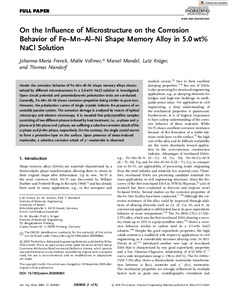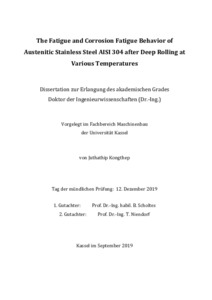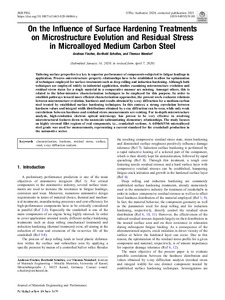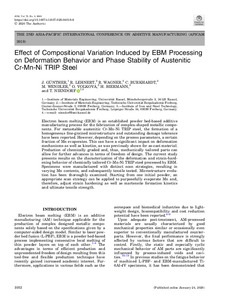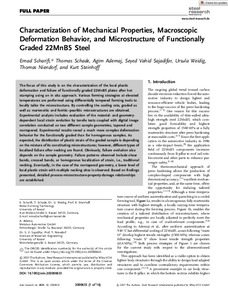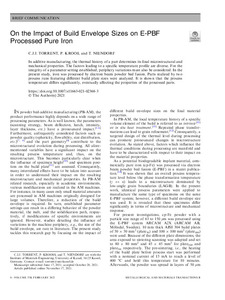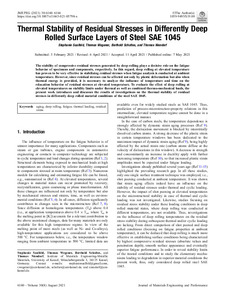Suche
Anzeige der Dokumente 71-80 von 90
Aufsatz

 On the Influence of Microstructure on the Corrosion Behavior of Fe–Mn–Al–Ni Shape Memory Alloy in 5.0 wt% NaCl Solution
On the Influence of Microstructure on the Corrosion Behavior of Fe–Mn–Al–Ni Shape Memory Alloy in 5.0 wt% NaCl Solution
(2020-10-03)
Herein the corrosion behavior of Fe–Mn–Al–Ni shape memory alloys characterized by different microstructures in a 5.0 wt% NaCl solution is investigated. Open circuit potential and potentiodynamic polarisation tests are conducted. Generally, Fe–Mn–Al–Ni shows corrosion properties being similar to pure iron. However, the polarization curves of single crystals indicate the presence of an unstable passive system. The corrosion damage is analyzed by means of optical microscopy and electron microscopy. It is revealed that ...
Dissertation
 The Fatigue and Corrosion Fatigue Behavior of Austenitic Stainless Steel AISI 304 after Deep Rolling at Various Temperatures
The Fatigue and Corrosion Fatigue Behavior of Austenitic Stainless Steel AISI 304 after Deep Rolling at Various Temperatures
(2019-09)
The austenitic stainless steel AISI 304 was deep rolled at 20 °C (RTDR), -195 °C (CTDR), and 550 °C (HTDR). The deep rolling pressures used for each deep rolling temperature were 1.0, 1.7, and 2.4 bar. From microstructural investigation, the largest compressive residual stress field was found in RTDR, and the highest amount of martensitic content and plastic deformation were found in CTDR. The strain aging effect was only found in HTDR.
In the rotating bending fatigue tests, the strain aging effect after HTDR is ...
Aufsatz

 On the Influence of Surface Hardening Treatments on Microstructure Evolution and Residual Stress in Microalloyed Medium Carbon Steel
On the Influence of Surface Hardening Treatments on Microstructure Evolution and Residual Stress in Microalloyed Medium Carbon Steel
(2020-06-09)
Tailoring surface properties is a key to superior performance of components subjected to fatigue loadings in application. Process–microstructure–property relationships have to be established to allow for optimization of techniques employed for surface treatments such as deep rolling and induction hardening. Although both techniques are employed widely in industrial application, studies examining microstructure evolution and residual stress states for a single material in a comparative manner are missing. Amongst ...
Aufsatz

 Effect of Compositional Variation Induced by EBM Processing on Deformation Behavior and Phase Stability of Austenitic Cr-Mn-Ni TRIP Steel
Effect of Compositional Variation Induced by EBM Processing on Deformation Behavior and Phase Stability of Austenitic Cr-Mn-Ni TRIP Steel
(2020-01-24)
Electron beam melting (EBM) is an established powder bed-based additive manufacturing process for the fabrication of complex-shaped metallic components. For metastable austenitic Cr-Mn-Ni TRIP steel, the formation of a homogeneous fine-grained microstructure and outstanding damage tolerance have been reported. However, depending on the process parameters, a certain fraction of Mn evaporates. This can have a significant impact on deformation mechanisms as well as kinetics, as was previously shown for as-cast material. ...
Aufsatz

 Characterization of Mechanical Properties, Macroscopic Deformation Behavior, and Microstructure of Functionally Graded 22MnB5 Steel
Characterization of Mechanical Properties, Macroscopic Deformation Behavior, and Microstructure of Functionally Graded 22MnB5 Steel
(2021-03-24)
The focus of this study is on the characterization of the local plastic deformation and failure of functionally graded 22MnB5 plates after hot stamping using an in situ approach. Various forming strategies at elevated temperatures are performed using differentially tempered forming tools to locally tailor the microstructure. By controlling the cooling rate, graded as well as martensitic and ferritic–pearlitic microstructures are obtained. Experimental analysis includes evaluation of the material- and geometry-dependent ...
Aufsatz

 On the Impact of Texture and Grain Size on the Pseudoelastic Properties of Polycrystalline Fe–Ni–Co–Al–Ti Alloy
On the Impact of Texture and Grain Size on the Pseudoelastic Properties of Polycrystalline Fe–Ni–Co–Al–Ti Alloy
(2020-05-08)
The effects of thermomechanical treatments on crystallographic texture and grain size evolution and their impact on the pseudoelastic properties in Fe41–Ni28–Co17–Al11.5–Ti2.5 (at.%) were studied in the present paper. The results show that cold rolling leads to brass-type texture in this alloy, which is typical for low stacking fault energy materials. Thermal treatments up to 1300 °C were conducted and it is shown that the presence of β-phase helps to control grain growth. After the dissolution of the secondary phase ...
Aufsatz

 On the Impact of Build Envelope Sizes on E-PBF Processed Pure Iron
On the Impact of Build Envelope Sizes on E-PBF Processed Pure Iron
(2021-11-17)
In additive manufacturing, the thermal history of a part determines its final microstructural and mechanical properties. The factors leading to a specific temperature profile are diverse. For the integrity of a parameter setting established, periphery variations must also be considered. In the present study, iron was processed by electron beam powder bed fusion. Parts realized by two process runs featuring different build plate sizes were analyzed. It is shown that the process temperature differs significantly, ...
Aufsatz

 On the Microstructural and Cyclic Mechanical Properties of Pure Iron Processed by Electron Beam Melting
On the Microstructural and Cyclic Mechanical Properties of Pure Iron Processed by Electron Beam Melting
(2021-03-10)
Additive manufacturing (AM) processes such as electron beam melting (EBM) are characterized by unprecedented design freedom. Topology optimization and design of the microstructure of metallic materials are enabled by rapid progress in this field. The latter is of highest importance as many applications demand appropriate mechanical as well as functional material properties. For instance, biodegradable implants have to meet mechanical properties of human bone and at the same time guarantee adequate cytocompatibility ...
Aufsatz

 CuCrZr processed by laser powder bed fusion — Processability and influence of heat treatment on electrical conductivity, microstructure and mechanical properties
CuCrZr processed by laser powder bed fusion — Processability and influence of heat treatment on electrical conductivity, microstructure and mechanical properties
(2021-06-16)
CuCrZr parts were fabricated by laser beam powder bed fusion (LB-PBF) technique and subjected to different heat treatments. As a result, four different conditions were considered for further investigations, that is, the as-built condition, conditions of maximum hardness (MH) and maximum electrical conductivity (MC), and a condition representing a compromise between hardness and conductivity (H&C). Microstructural evolution and performance under monotonic and cyclic loading were studied. Fracture surfaces revealed ...
Aufsatz

 Thermal Stability of Residual Stresses in Differently Deep Rolled Surface Layers of Steel SAE 1045
Thermal Stability of Residual Stresses in Differently Deep Rolled Surface Layers of Steel SAE 1045
(2021-05-07)
The stability of compressive residual stresses generated by deep rolling plays a decisive role on the fatigue behavior of specimens and components, respectively. In this regard, deep rolling at elevated temperature has proven to be very effective in stabilizing residual stresses when fatigue analysis is conducted at ambient temperature. However, since residual stresses can be affected not only by plastic deformation but also when thermal energy is provided, it is necessary to analyze the influence of temperature and ...

